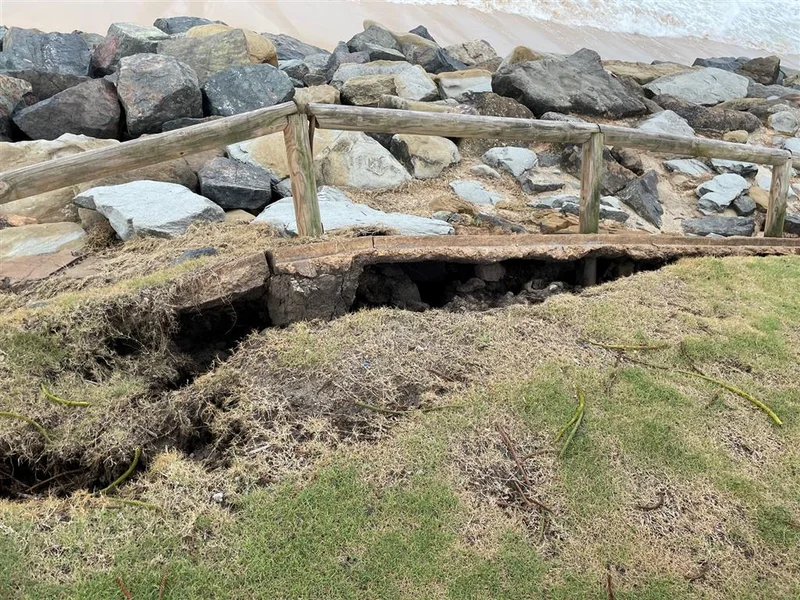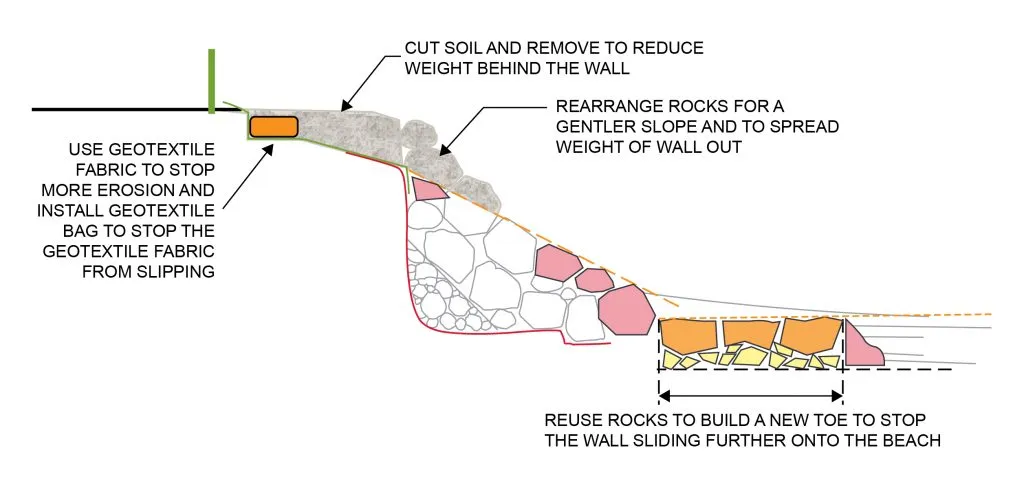Moffat Beach seawall temporary fix starts today
Sunshine Coast Council will start emergency repair works today (Wednesday, April 20) to temporarily fix the Moffat Beach seawall to ensure it’s safe for our community.

Sunshine Coast Council will start emergency repair works today (Wednesday, April 20) to temporarily fix the Moffat Beach seawall to ensure it’s safe for our community.
It comes as council immediately cordoned off the area and alerted the community to avoid the Moffat Beach seawall following February’s severe weather event.
Independent geotechnical and coastal engineers were engaged to assess the damage to the seawall and provide repair solutions.
The investigation found approximately 80 metres of the seawall had been damaged which included slumping of a 30-metre section of the wall and significant cracking in other areas.
The beach access ramp and nearby beach stairs are also within the failure area of the wall and are unsafe for public access.
The report recommended immediate work to make the slumping section of the wall safe in the short-term, to allow time to develop a carefully designed, long-term repair solution, including repairs to park infrastructure and beach accesses.

Emergency work to make the Moffat Beach seawall safe
Sunshine Coast Council Division 2 Councillor Terry Landsberg said council’s priority was to make the Moffat Beach foreshore safe for the community.
“Repairing the seawall presents an opportunity to create an even better and more usable outcome for the area in the future, but we urgently need to first ensure it’s safe for our entire community and visitors to the region,” Cr Landsberg said.
“The first stage of work will focus on temporary repairs to the wall to stop the crack expanding and the seawall failing further.
“When it’s finished, the temporary wall will look different to the existing wall as it will be wider with a gentler slope.
“This won’t be the final product as in the background council is developing a plan to fix the remainder of the damaged wall, which is about 80 metres in total. This section will be rebuilt again as part of that project.”
During the emergency work, rocks will be removed from the top of the wall to reduce the weight and pressure bearing down on the base of the wall – also known as a “toe”.
The “toe” will be reinforced and made wider to prevent the wall sliding further onto the beach.
The rocks will be rearranged along the wall to achieve a gentler slope, spreading the weight of the wall out over a wider surface area.
The soil at the top of the wall will also need to be removed and formed into a gentle slope and fabric will be placed on top of the exposed dirt to stop more erosion.
The beach access and ramp will remain closed as these need to be completely rebuilt, which will occur during the second stage of major works later in the year.
When finished, most of the area will be open again to the public while stage two is designed.
Cr Landsberg said regrettably some vegetation would need to be removed as part of the short-term repair work.
“Unfortunately, as part of the repair work, it’s essential that two nearby Norfolk Pines will need to be removed but more shade trees will be planted during the major rebuild of the wall towards the end of the year,” Cr Landsberg said.
“We know the trees along the Moffat Beach foreshore are extremely important to our community, and every scenario has been explored to avoid this necessary step.
“However, to make the seawall safe, it needs to be made wider and soil at the top of the wall needs to be removed.
“This will encroach into the structure root zone of two nearby Norfolk Pine trees.
“If the structural root system is damaged, it’s highly likely that in future high wind or storm events, these trees would fall landward across the footpath, park and car park potentially causing severe injury, even death, to any person nearby.
“Obviously this is not something council is willing to risk, particularly with nearby playgrounds, carparks and many people frequenting the area. Everyone’s safety is our top priority.
“Council apologises for the inconvenience during construction and thanks the community for their patience as we work to make the foreshore area safe for everyone.”
Major works are scheduled to begin today, April 20, 2022, and are expected to take up to four weeks to complete, weather permitting.
Excavators and machinery will be working from the park and the beach, and traffic control will be on site for everyone’s safety.
The car park will need to be closed on occasion.
An assessment of the potential risk to the Norfolk Pine Trees has been carried out by an Arborist against the Australian Standard AS4970:2009 Protection of Trees on Development Sites.
A pandanus tree will need to be pruned as part of the work. A spotter catcher will inspect the trees for wildlife before any work begins.
Why can’t you work around the roots of the Norfolks or move the wall further onto the beach so the tree roots aren’t damaged?
The engineers designing emergency repair work have worked hand in hand with a geotechnical engineer and considered all options to try and keep the trees.
To avoid the two Norfolks entirely, the footprint of the wall would need to extend significantly further seaward. We would need approval from the Queensland Government, Department of Environment and Science (DES) to be able to do this. DES have advised that, in their view, this will impact on coastal processes which they are not supportive of..
This would also have a significant impact of the amount of available beach in this area.
The structural root zone of the trees is about 2.8 metres in diameter. The emergency work to repair the wall will take place within this structural root zones of the trees. This will reduce the stability of the trees leading to a high risk that the trees could fall over – a risk council is not willing to take.
In the end, due to the size of the trees and the structural root zone, we are unable to both make the wall safe again and keep the trees.
Can you cut the trees down to a smaller size?
An arborist has advised that it’s very unlikely the trees would recover from this due to the tree species. The work would also cause significant damage to the roots of the trees.
Do the trees have any specific heritage?
We think the trees were planted around 1930s. We’ve investigated and can’t find any specific reason for their planting. If you know more or a reason, please let us know.
Will you be rebuilding this section of the wall again later in the year or is this the finished product?
This is not the final product. We are currently working through the final design to fix the remainder of the seawall which we anticipate will be constructed late in the year. This section will be rebuilt at that time in line with the final design.
Can you reopen the boat ramp?
The ramp has significantly cracked so needs repairs. This will take place during the major repair works later in the year. It’ll remain closed until then.
Will you replace the table and chairs?
We are looking into a short-term temporary solution for providing seating in this area until the major work can be complete later in the year. Plaques were found on two of the chairs facing the ocean. These will be replaced in a similar spot and similar location after the work is finished.
More information is available at sunshinecoast.qld.gov.au/mbseawall
Last edited on:
First published on: